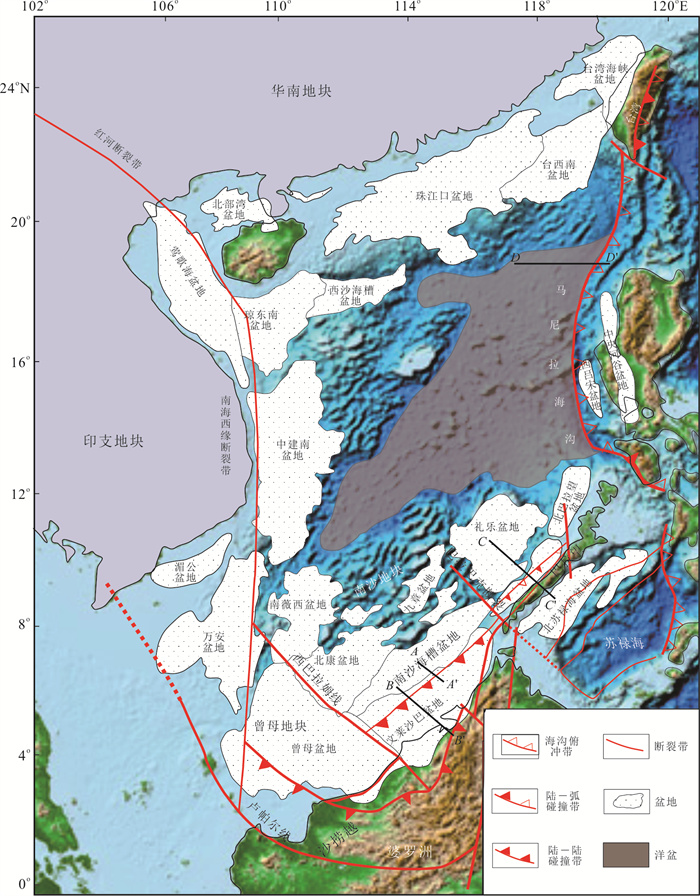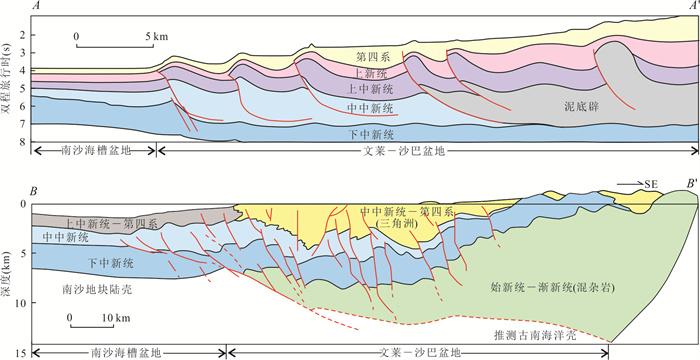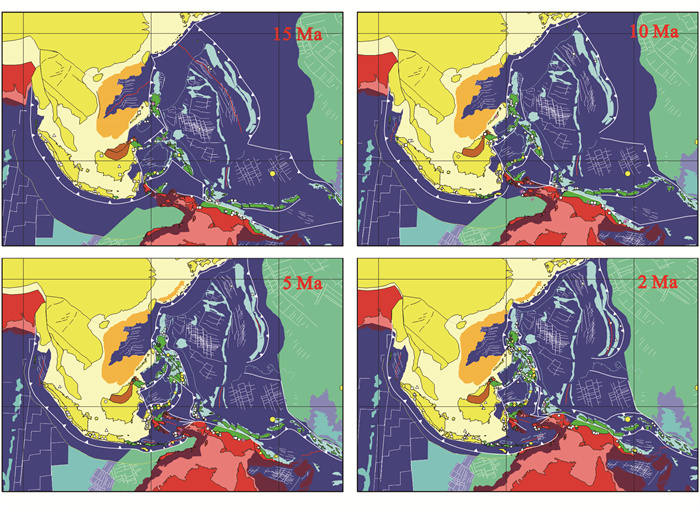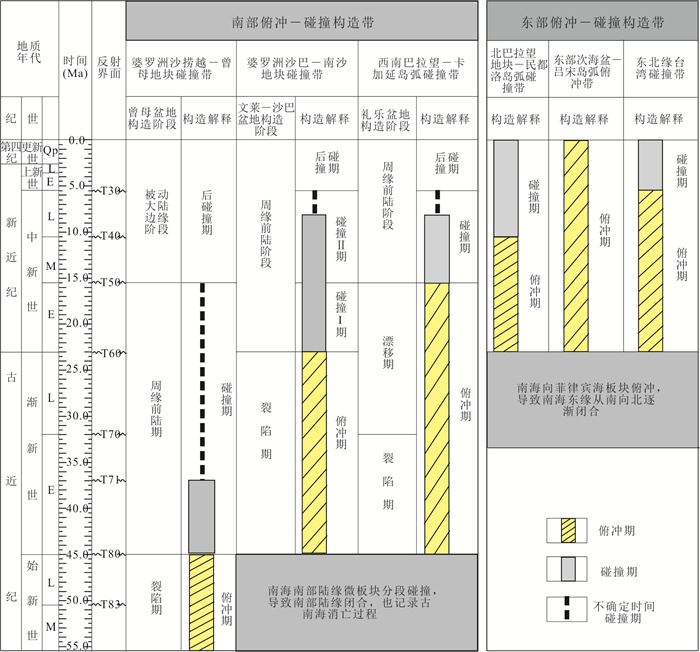Marginal Sea Closure Process and Genetic Mechanism of South China Sea during Post-Spreading Period
-
摘要: 南海是西太平洋海域最大的边缘海,然而南海扩张终结后动力学过程研究仍较为薄弱.通过构造变革界面识别、褶皱冲断带沉积记录等方面的系统研究,揭示南海南部和东部陆缘在南海后扩张期的演化历程.研究表明南海南部和东部边缘经历了多个微板块从俯冲到碰撞的演变历程,形成了陆-陆碰撞、弧-陆碰撞、洋-弧俯冲等多个特征迥异的板块边界.南海南部陆缘属于古南海俯冲拖曳构造区,婆罗洲西北沙捞越-曾母地块率先碰撞,随后经历了婆罗洲东北沙巴-南沙地块碰撞、西南巴拉望-卡加延岛弧碰撞.南部多个微板块碰撞导致古南海呈剪刀式从西向东逐渐关闭和消亡,总体形成了以微地块碰撞、深海槽发育和造山带前缘巨厚沉积充填为特色的碰撞陆缘.东部陆缘属于菲律宾海俯冲-碰撞构造区,南海东部洋壳自中新世开始向菲律宾海板块俯冲,弧-陆碰撞仅局限于东部陆缘南北两端.澳洲-印度板块、菲律宾海板块与欧亚板块相互作用控制了南海边缘海闭合过程,南海正在进行的关闭过程主要集中在东缘和南缘,东缘呈现了以南海洋壳消亡为特征的闭合过程,而南缘则呈现以微陆块碰撞为特征的古南海闭合过程.显然,南部后扩张期陆缘演变可为边缘海闭合过程研究提供极佳的范例,同时对我国海洋权益保护和南海大陆边缘动力学研究具有重要意义.Abstract: The South China Sea (SCS) is the largest marginal sea in the West Pacific, but the study of dynamic processes after the termination of the SCS seafloor spreading is not so clear. In this paper it reveals the evolution of the southern and eastern margins of the SCS during the post-SCS spreading period through systematic studies on the identification of tectonically unconformities, contemporaneous sedimentary records of fold-and-thrust belt. The results show that the southern and eastern margins of the SCS have undergone the evolution of multiple microplates from subduction to collision since the Miocene. Several collision boundaries with different characteristics were developed, including continent-continent collision, arc-continent collision and ocean-arc subduction. The southern margin of the SCS belongs to the proto-SCS slab pull tectonic zone, the Sarawak-Zengmu block in northwest Borneo took the lead in the collision, followed by the Sabah-Nansha block collision in northeast Borneo and the Palawan-Cagayan arc collision in the southwest Palawan island. Since the Middle Miocene, these tectonic events have led to the gradual extinction of the proto-SCS from west to east in a scissor-like pattern, and in the formation of a southern collisional margin characterized by microplate collisions, deep-sea trough development and thick sediments filling in the orogenic foreland. The eastern margin of the SCS is part of the Philippine subduction-collision tectonic zone. Subduction of the SCS oceanic crust to the Philippine Sea plate began in the Miocene, but the arc-continent collisions confined to the northern and southern ends of the eastern margin with further oblique subduction of the Philippine Sea plate. The interaction among the Australia-India plate, the Philippine Sea plate and the Eurasian plate controls the marginal sea closure process in the SCS. The ongoing closure process in the SCS is mainly concentrated on the southern and eastern margins, the eastern margin shows a closure process characterized by the extinction of oceanic crust, while the southern margin is a closure process characterized by the collision of microplates. Therefore, the continental margin evolution during the post-SCS spreading period can provide an excellent example for the study of marginal sea closure process, and is also important for the protection of national maritime rights and interests and the study of the dynamics of continental margins in the SCS.
-
图 8 南海中中新世以来构造演化图(据Hall,2002)
Fig. 8. Tectonic reconstruction diagrams of South China Sea since the Middle Miocene (modified after Hall, 2002)
-
Aurelio, M. A., Forbes, M. T., Taguibao, K. J. L., et al., 2014. Middle to Late Cenozoic Tectonic Events in South and Central Palawan (Philippines) and Their Implications to the Evolution of the South-Eastern Margin of South China Sea: Evidence from Onshore Structural and Offshore Seismic Data. Marine and Petroleum Geology, 58: 658-673. https://doi.org/10.1016/j.marpetgeo.2013.12.002 Balaguru, A., Nichols, G., 2004. Tertiary Stratigraphy and Basin Evolution, Southern Sabah (Malaysian Borneo). Journal of Asian Earth Sciences, 23(4): 537-554. https://doi.org/10.1016/j.jseaes.2003.08.001 Beck, R. A., Burbank, D. W., Sercombe, W. J., et al., 1996. Late Cretaceous Ophiolite Obduction and Paleocene India-Asia Collision in the Westernmost Himalaya. Geodinamica Acta, 9(2/3): 114-144. https://doi.org/10.1080/09853111.1996.11105281 Breitfeld, H. T., Hall, R., Galin, T., et al., 2017. A Triassic to Cretaceous Sundaland-Pacific Subduction Margin in West Sarawak, Borneo. Tectonophysics, 694: 35-56. https://doi.org/10.1016/j.tecto.2016.11.034 Briais, A., Patriat, P., Tapponnier, P., 1993. Updated Interpretation of Magnetic Anomalies and Seafloor Spreading Stages in the South China Sea: Implications for the Tertiary Tectonics of Southeast Asia. Journal of Geophysical Research: Solid Earth, 98(B4): 6299-6328. https://doi.org/10.1029/92jb02280 Briais, A., Sloan, H., Parson, L., et al., 2000. Accretionary Processes in the Axial Valley of the Mid-Atlantic Ridge 27° N-30° N from TOBI Side-Scan Sonar Images. Marine Geophysical Research, 21(1): 87-119. https://doi.org/10.1023/A: 1004722213652 doi: 10.1023/A:1004722213652 Chen, H., Xie, X. N., Mao, K. N., et al., 2020. Depositional Characteristics and Formation Mechanisms of Deep-Water Canyon Systems along the Northern South China Sea Margin. Journal of Earth Science, 31(4): 808-819. https://doi.org/10.1007/s12583-020-1284-z Clift, P. D., Carter, A., Campbell, I. H., et al., 2006. Thermochronology of Mineral Grains in the Red and Mekong Rivers, Vietnam: Provenance and Exhumation Implications for Southeast Asia. Geochemistry, Geophysics, Geosystems, 7(10): 1-28. https://doi.org/10.1029/2006gc001336 Cullen, A., 2014. Nature and Significance of the West Baram and Tinjar Lines, NW Borneo. Marine and Petroleum Geology, 51: 197-209. https://doi.org/10.1016/j.marpetgeo.2013.11.010 Cullen, A., Reemst, P., Henstra, G., et al., 2010. Rifting of the South China Sea: New Perspectives. Petroleum Geoscience, 16(3): 273-282. doi: 10.1144/1354-079309-908 Ding, W. W., Li, J. B., Li, J., et al., 2013. Morphotectonics and Evolutionary Controls on the Pearl River Canyon System, South China Sea. Marine Geophysical Research, 34(3): 221-238. https://doi.org/10.1007/s11001-013-9173-9 Eakin, C. M., Lithgow-Bertelloni, C., Dávila, F. M., 2014. Influence of Peruvian Flat-Subduction Dynamics on the Evolution of Western Amazonia. Earth and Planetary Science Letters, 404: 250-260. https://doi.org/10.1016/j.epsl.2014.07.027 Fan, J. K., Zhao, D. P., 2018. Evolution of the Southern Segment of the Philippine Trench: Constraints from Seismic Tomography. Geochemistry, Geophysics, Geosystems, 19(11): 4612-4627. https://doi.org/10.1029/2018GC007685 Fang, X. D., Zhang, A. M., Wang, Y. J., et al., 2021. Geochronoloy and Geochemical Characteristics of Lundu Mafic Rocks in Kuching Area, Sarawak. Earth Science, 46(6): 2133-2144(in Chinese with English abstract). Franke, D., Barckhausen, U., Heyde, I., et al., 2008. Seismic Images of a Collision Zone Offshore NW Sabah/Borneo. Marine and Petroleum Geology, 25(7): 606-624. https://doi.org/10.1016/j.marpetgeo.2007.11.004 Franke, D., Savva, D., Pubellier, M., et al., 2014. The Final Rifting Evolution in the South China Sea. Marine and Petroleum Geology, 58: 704-720. https://doi.org/10.1016/j.marpetgeo.2013.11.020 Fuh, S. C., Liu, C. S., Lundberg, N., et al., 1997. Strike-Slip Faults Offshore Southern Taiwan: Implications for the Oblique Arc-Continent Collision Processes. Tectonophysics, 274(1/2/3): 25-39. https://doi.org/10.1016/S0040-1951(96)00296-X Galin, T., Breitfeld, H. T., Hall, R., et al., 2017. Provenance of the Cretaceous-Eocene Rajang Group Submarine Fan, Sarawak, Malaysia from Light and Heavy Mineral Assemblages and U-Pb Zircon Geochronology. Gondwana Research, 51: 209-233. https://doi.org/10.1016/j.gr.2017.07.016 Gatinsky, Y. G., Hutchison, C. S., 1986. Cathaysia, Gondwanaland, and the Paleotethys in the Evolution of Continental Southeast Asia. International Surgery, 55(1): 32-41. Hall, R., 1996. Reconstructing Cenozoic SE Asia. Geological Society, London, Special Publications, 106(1): 153-184. https://doi.org/10.1144/gsl.sp.1996.106.01.11 Hall, R., 2002. Cenozoic Geological and Plate Tectonic Evolution of SE Asia and the SW Pacific: Computer-Based Reconstructions, Model and Animations. Journal of Asian Earth Sciences, 20(4): 353-431. https://doi.org/10.1016/S1367-9120(01)00069-4 Hall, R., Breitfeld, H. T., 2017. Nature and Demise of the Proto-South China Sea. Bulletin of the Geological Society of Malaysia, 63: 61-76. doi: 10.7186/bgsm63201703 Hamilton, W. B., 1973. Tectonics of the Indonesian Region. Bulletin of the Geological Society of Malaysia, 6: 3-10. https://doi.org/10.7186/bgsm06197301 Haq, B. U., Hardenbol, J., Vail, P. R., 1987. Chronology of Fluctuating Sea Levels since the Triassic. Science, 235: 1156-1167. https://doi.org/10.1126/science.235.4793.1156 He, M., Zhong, G. F., Liu, X. F., et al., 2017. Rapid Post-Rift Tectonic Subsidence Events in the Pearl River Mouth Basin, Northern South China Sea Margin. Journal of Asian Earth Sciences, 147: 271-283. https://doi.org/10.1016/j.jseaes.2017.07.024 Hesse, S., Back, S., Franke, D., 2009. The Deep-Water Fold-and-Thrust Belt Offshore NW Borneo: Gravity-Driven versus Basement-Driven Shortening. Geological Society of America Bulletin, 121(5/6): 939-953. https://doi.org/10.1130/b26411.1 Hinz, K., Fritsch, J., Kempter, E. H. K., et al., 1989. Thrust Tectonics along the North-Western Continental Margin of Sabah/Borneo. Geologische Rundschau, 78(3): 705-730. https://doi.org/10.1007/BF01829317 Hoang, B. H., Fyhn, M. B. W., Tong, D. C., et al., 2020. Paleogene Structural Development of the Northern Song Hong Basin and Adjacent Areas: Implications for the Role of Extrusion Tectonics in Basin Formation in the Gulf of Tonkin. Tectonophysics, 789: 228522. https://doi.org/10.1016/j.tecto.2020.228522 Honza, E., John, J., Banda, R. M., 2000. An Imbrication Model for the Rajang Accretionary Complex in Sarawak, Borneo. Journal of Asian Earth Sciences, 18(6): 751-759. https://doi.org/10.1016/S1367-9120(00)00044-4 Hsiung, K. H., Yu, H. S., 2011. Morpho-Sedimentary Evidence for a Canyon-Channel-Trench Interconnection along the Taiwan-Luzon Plate Margin, South China Sea. Geo-Marine Letters, 31(4): 215-226. https://doi.org/10.1007/s00367-010-0226-7 Hu, X. M., An, W., Garzanti, E., et al., 2020. Recognition of Trench Basins in Collisional Orogens: Insights from the Yarlung Zangbo Suture Zone in Southern Tibet. Science China Earth Sciences, 63(12): 2017-2028. https://doi.org/10.1007/s11430-019-9687-x Huang, C. Y., Chen, W. H., Wang, M. H., et al., 2018. Juxtaposed Sequence Stratigraphy, Temporal-Spatial Variations of Sedimentation and Development of Modern-Forming Forearc Lichi Mélange in North Luzon Trough Forearc Basin Onshore and Offshore Eastern Taiwan: An Overview. Earth-Science Reviews, 182: 102-140. https://doi.org/10.1016/j.earscirev.2018.01.015 Huang, C. Y., Wang, P. X., Yu, M. M., et al., 2019. Potential Role of Strike-Slip Faults in Opening up the South China Sea. National Science Review, 6(5): 891-901. https://doi.org/10.1093/nsr/nwz119 Huang, C. Y., Yan, Y., Zhao, Q. H., et al., 2012. Cenozoic Stratigraphy of Taiwan: Looking into Rifting, Stratigraphy and Paleoceanography of South China Sea. Chinese Science Bulletin, 57(20): 1842-1862 (in Chinese). doi: 10.1360/csb2012-57-20-1842 Huang, C. Y., Yuan, P. B., Lin, C. W., et al., 2000. Geodynamic Processes of Taiwan Arc-Continent Collision and Comparison with Analogs in Timor, Papua New Guinea, Urals and Corsica. Tectonophysics, 325(1/2): 1-21. https://doi.org/10.1016/S0040-1951(00)00128-1 Huang, C. Y., 2017. Geological Ages of Taiwan Stratigraphy and Tectonic Events. Scientia Sinica Terrae, 47(4): 394-405(in Chinese). doi: 10.1360/N072017-00023 Hutchison, C. S., 1996. The 'Rajang Accretionary Prism' and 'Lupar Line' Problem of Borneo. Geological Society, London, Special Publications, 106(1): 247-261. https://doi.org/10.1144/gsl.sp.1996.106.01.16 Hutchison, C. S., 2004. Marginal Basin Evolution: The Southern South China Sea. Marine and Petroleum Geology, 21(9): 1129-1148. https://doi.org/10.1016/j.marpetgeo.2004.07.002 Hutchison, C. S., 2010. The North-West Borneo Trough. Marine Geology, 271(1/2): 32-43. https://doi.org/10.1016/j.margeo.2010.01.007 Hutchison, C. S., Bergman, S. C., Swauger, D. A., et al., 2000. A Miocene Collisional Belt in North Borneo: Uplift Mechanism and Isostatic Adjustment Quantified by Thermochronology. Journal of the Geological Society, 157(4): 783-793. https://doi.org/10.1144/jgs.157.4.783 Ilao, K. A., Morley, C. K., Aurelio, M. A., 2018.3D Seismic Investigation of the Structural and Stratigraphic Characteristics of the Pagasa Wedge, Southwest Palawan Basin, Philippines, and Their Tectonic Implications. Journal of Asian Earth Sciences, 154: 213-237. https://doi.org/10.1016/j.jseaes.2017.12.017 Karig, D. E., 1983. Accreted Terranes in the Northern Part of the Philippine Archipelago. Tectonics, 2(2): 211-236. https://doi.org/10.1029/tc002i002p00211 Lai, C., Xia, X. P., Hall, R., et al., 2021. Cenozoic Evolution of the Sulu Sea Arc-Basin System: An Overview. Tectonics, 40(2): e2020TC006630. https://doi. org/10.1029/2020TC006630 doi: 10.1029/2020TC006630 Lee, Y. H., Byrne, T., Wang, W. H., et al., 2015. Simultaneous Mountain Building in the Taiwan Orogenic Belt. Geology, 43(5): 451-454. https://doi.org/10.1130/g36373.1 Lei, C., Ren, J. Y., 2016. Hyper-Extended Rift Systems in the Xisha Trough, Northwestern South China Sea: Implications for Extreme Crustal Thinning ahead of a Propagating Ocean. Marine and Petroleum Geology, 77: 846-864. https://doi.org/10.1016/j.marpetgeo.2016.07.022 Lester, R., McIntosh, K., van Avendonk, H. J. A., et al., 2013. Crustal Accretion in the Manila Trench Accretionary Wedge at the Transition from Subduction to Mountain-Building in Taiwan. Earth and Planetary Science Letters, 375: 430-440. https://doi.org/10.1016/j.epsl.2013.06.007 Li, C. F., Clift, P. D., Sun, Z., et al., 2019. Starting a New Ocean and Stopping It. Oceanography, 32(1): 153-156. doi: 10.5670/oceanog.2019.138 Li, J. B., Ding, W. W., Lin, J., et al., 2021. Dynamic Processes of the Curved Subduction System in Southeast Asia: A Review and Future Perspective. Earth-Science Reviews, 217: 103647. https://doi.org/10.1016/j.earscirev.2021.103647 Li, J. B., Jin, X. L., Ruan, A. G., et al., 2004. Extrusion Structure in the Middle Section of Accretionary Wedge in Manila Trench. Chinese Science Bulletin, 49(10): 1000-1008(in Chinese). doi: 10.1360/csb2004-49-10-1000 Lin, J., Li, J. B., Xu, Y. G., et al., 2019. Ocean Drilling and Major Advances in Marine Geological and Geophysical Research of the South China Sea. Haiyang Xuebao, 41(10): 125-140(in Chinese with English abstract). Luo, W. D., Zhou, J., Li, X. J., et al., 2018. Morphology and Structure and Evolution of West Basin Canyon, South China Sea. Earth Science, 43(6): 2172-2183(in Chinese with English abstract). Lourens, L. J., Hilgen, F. J., Shackleton, N. J., et al., 2004. The Neogene Period. In: Gradstein, F. M., Ogg, J. G., Smith, A. G., eds., A Geologic Time Scale. Cambridge University Press, Cambridge: 409-440. Morley, C. K., 2002. A Tectonic Model for the Tertiary Evolution of Strike-Slip Faults and Rift Basins in SE Asia. Tectonophysics, 347(4): 189-215. https://doi.org/10.1016/S0040-1951(02)00061-6 Morley, C. K., King, R., Hillis, R., et al., 2011. Deepwater Fold and Thrust Belt Classification, Tectonics, Structure and Hydrocarbon Prospectivity: A Review. Earth-Science Reviews, 104(1/2/3): 41-91. https://doi.org/10.1016/j.earscirev.2010.09.010 Rangin, C., Bellon, H., Benard, F., et al., 1990. Neogene Arc-Continent Collision in Sabah, Northern Borneo (Malaysia). Tectonophysics, 183(1/2/3/4): 305-319. https://doi.org/10.1016/0040-1951(90)90423-6 Ren, J. Y., Lei, C., 2011. Tectonic Stratigraphic Framework of Yinggehai-Qiongdongnan Basins and Its Implication for Tectonic Province Division in South China Sea. Chinese Journal of Geophysics, 54(12): 3303-3314(in Chinese with English abstract). doi: 10.3969/j.issn.0001-5733.2011.12.028 Sandal, S. T., 1996. The Geology and Hydrocarbon Resources of Negara Brunei Darussalam. Brunei Shell Petroleum /Brunei Museum, Syabas Bandar Seri Begawan, Brunei Darussalam. Sibuet, J. C., Yeh, Y. C., Lee, C. S., 2016. Geodynamics of the South China Sea. Tectonophysics, 692: 98-119. https://doi.org/10.1016/j.tecto.2016.02.022 Steuer, S., Franke, D., Meresse, F., et al., 2013. Time Constraints on the Evolution of Southern Palawan Island, Philippines from Onshore and Offshore Correlation of Miocene Limestones. Journal of Asian Earth Sciences, 76: 412-427. https://doi.org/10.1016/j.jseaes.2013.01.007 Su, M., Zhang, C., Xie, X. N., et al., 2014. Controlling Factors on the Submarine Canyon System: A Case Study of the Central Canyon System in the Qiongdongnan Basin, Northern South China Sea. Science China Earth Sciences, 57(10): 2457-2468. https://doi.org/10.1007/s11430-014-4878-4 Sun, Z., Zhong, Z. H., Zhou, D., 2007. The Analysis and Analogue Modeling of the Tectonic Evolution and Strong Subsidence in the Yinggehai Basin. Earth Science, 32(3): 347-356(in Chinese with English abstract). doi: 10.3321/j.issn:1000-2383.2007.03.007 Tamayo, R. A. Jr, Maury, R. C., Yumul, G. P. Jr, et al., 2004. Subduction-Related Magmatic Imprint of Most Philippine Ophiolites: Implications on the Early Geodynamic Evolution of the Philippine Archipelago. Bulletin De La Société Géologique De France, 175(5): 443-460. https://doi.org/10.2113/175.5.443 Tate, R. B., 2001. The Geology of Borneo Island. Geological Society of Malaysia, Malaysia. Taylor, B., Hayes, D. E., 1983. Origin and History of the South China Sea Basin. The Tectonic and Geologic Evolution of Southeast Asian Seas and Islands: Part 2. American Geophysical Union, Washington, D. C., 23-56. https://doi.org/10.1029/gm027p0023 van Hattum, M. W. A., Hall, R., Pickard, A. L., et al., 2013. Provenance and Geochronology of Cenozoic Sandstones of Northern Borneo. Journal of Asian Earth Sciences, 76: 266-282. https://doi.org/10.1016/j.jseaes.2013.02.033 Wang, P. X., 2012. Tracing the Life History of a Marginal Sea—On "the South China Sea Deep" Research Program. Chinese Science Bulletin, 57(20): 1807-1826 (in Chinese). doi: 10.1360/csb2012-57-20-1807 Wang, L. J., Sun, Z., Yao, Y. J., et al., 2021. Development Characteristics of Nido Carbonate Platform and Its Tectonic Controls in the Southeast of South China Sea Margin. Earth Science, 46(3): 956-974(in Chinese with English abstract). Wang, L. J., Yao, Y. J., Sun, Z., et al., 2019. Characteristics of Interface S3 (the End of Middle Miocene) on the Southeast South China Sea Margin and Its Geological Implications. Marine Geology & Quaternary Geology, 39(4): 75-86(in Chinese with English abstract). Wang, P. X., 2020. Exploring the Deep Sea Processes in the South China Sea. Science & Technology Review, 38(18): 6-20(in Chinese with English abstract). Wang, P. X., Huang, C. Y., Lin, J., et al., 2019. The South China Sea is not a Mini-Atlantic: Plate-Edge Rifting vs Intra-Plate Rifting. National Science Review, 6(5): 902-913. https://doi.org/10.1093/nsr/nwz135 Wu, J., Suppe, J., Lu, R. Q., et al., 2016. Philippine Sea and East Asian Plate Tectonics since 52 Ma Constrained by New Subducted Slab Reconstruction Methods. Journal of Geophysical Research: Solid Earth, 121(6): 4670-4741. https://doi.org/10.1002/2016JB012923 Xie, X. N., Müller, R. D., Li, S. T., et al., 2006. Origin of Anomalous Subsidence along the Northern South China Sea Margin and Its Relationship to Dynamic Topography. Marine and Petroleum Geology, 23(7): 745-765. https://doi.org/10.1016/j.marpetgeo.2006.03.004 Xie, Y. H., Zhang, G. C., Tang, W., et al., 2020. Theoretical and Technological Innovation of Oil and Gas Accumulation and Major Exploration Breakthroughs in Deep-Water Areas, Northern South China Sea. Natural Gas Industry, 40(12): 1-11(in Chinese with English abstract). doi: 10.3787/j.issn.1000-0976.2020.12.001 Yan, P., Deng, H., Liu, H. L., et al., 2006. The Temporal and Spatial Distribution of Volcanism in the South China Sea Region. Journal of Asian Earth Sciences, 27(5): 647-659. https://doi.org/10.1016/j.jseaes.2005.06.005 Yao, B. C., Wan, L., Wu, N. Y., 2004. Cenozoic Plate Tectonic Activities in the Great South China Sea Area. Geology in China, 31(2): 113-122(in Chinese with English abstract). doi: 10.3969/j.issn.1000-3657.2004.02.001 Yao, Y. J., Lü, C. L., Kang, Y. S., et al., 2013. Characteristics of Hydrocarbon Source Rocks and Their Main Controlling Factors in Southeast Asia. Earth Science, 38(2): 367-378(in Chinese with English abstract). Yu, H. S., Chiang, C. S., Shen, S. M., 2009. Tectonically Active Sediment Dispersal System in SW Taiwan Margin with Emphasis on the Gaoping (Kaoping) Submarine Canyon. Journal of Marine Systems, 76(4): 369-382. https://doi.org/10.1016/j.jmarsys.2007.07.010 Yumul, G. P., 2007. Westward Younging Disposition of Philippine Ophiolites and Its Implication for Arc Evolution. Island Arc, 16(2): 306-317. https://doi.org/10.1111/j.1440-1738.2007.00573.x Yumul, G. P., Dimalanta, C. B., Tamayo, R. A., 2005. Indenter-Tectonics in the Philippines: Example from the Palawan Microcontinental Block-Philippine Mobile Belt Collision. Resource Geology, 55(3): 189-198. https://doi.org/10.1111/j.1751-3928.2005.tb00240.x Yumul, G. P. Jr, Dimalanta, C. B., Marquez, E. J., et al., 2009. Onland Signatures of the Palawan Microcontinental Block and Philippine Mobile Belt Collision and Crustal Growth Process: A Review. Journal of Asian Earth Sciences, 34(5): 610-623. https://doi.org/10.1016/j.jseaes.2008.10.002 Zhang, G. C., Shao, L., Qiao, P. J., et al., 2019. Cretaceous-Palaeogene Sedimentary Evolution of the South China Sea Region: A Preliminary Synthesis. Geological Journal, 55(4): 2662-2683. https://doi.org/10.1002/gj.3533 Zhang, G. C., Tang, W., Xie, X. J., et al., 2017. Petroleum Geological Characteristics of Two Basin Belts in Southern Continental Margin in South China Sea. Petroleum Exploration and Development, 44(6): 849-859(in Chinese with English abstract). Zhao, M. H., Sibuet, J. C., Wu, J., 2019. Intermingled Fates of the South China Sea and Philippine Sea Plate. National Science Review, 6(5): 886-890. https://doi.org/10.1093/nsr/nwz107 Zhao, Y. H., Tong, D. J., Song, Y., et al., 2016. Seismic Reflection Characteristics and Evolution of Intrusions in the Qiongdongnan Basin: Implications for the Rifting of the South China Sea. Journal of Earth Science, 27(4): 642-653. https://doi.org/10.1007/s12583-016-0708-2 Zhu, M. Z., Graham, S., McHargue, T., 2009. The Red River Fault Zone in the Yinggehai Basin, South China Sea. Tectonophysics, 476(3/4): 397-417. https://doi.org/10.1016/j.tecto.2009.06.015 房旭东, 张爱梅, 王岳军, 等, 2021. 沙捞越古晋地区伦杜基性岩的形成时代、地球化学特征及其地质意义. 地球科学, 46(6): 2133-2144. doi: 10.3799/dqkx.2020.048 黄奇瑜, 2017. 台湾岛的年龄. 中国科学: 地球科学, 47(4): 394-405. 黄奇瑜, 闫义, 赵泉鸿, 等, 2012. 台湾新生代层序: 反映南海张裂, 层序和古海洋变化机制. 科学通报, 57(20): 1842-1862. https://www.cnki.com.cn/Article/CJFDTOTAL-KXTB201220005.htm 李家彪, 金翔龙, 阮爱国, 等, 2004. 马尼拉海沟增生楔中段的挤入构造. 科学通报, 49(10): 1000-1008. doi: 10.3321/j.issn:0023-074X.2004.10.015 林间, 李家彪, 徐义刚, 等, 2019. 南海大洋钻探及海洋地质与地球物理前沿研究新突破. 海洋学报, 41(10): 125-140. doi: 10.3969/j.issn.0253-4193.2019.10.009 罗伟东, 周娇, 李学杰, 等, 2018. 南海海盆盆西峡谷的形态与结构及形成演化. 地球科学, 43(6): 2172-2183. doi: 10.3799/dqkx.2017.615 任建业, 雷超, 2011. 莺歌海—琼东南盆地构造-地层格架及南海动力变形分区. 地球物理学报, 54(12): 3303-3314. doi: 10.3969/j.issn.0001-5733.2011.12.028 孙珍, 钟志洪, 周蒂, 2007. 莺歌海盆地构造演化与强烈沉降机制的分析和模拟. 地球科学, 32(3): 347-356. http://www.earth-science.net/article/id/3460 王利杰, 孙珍, 姚永坚, 等, 2021. 南海东南部陆缘Nido灰岩发育特征及其构造控制因素. 地球科学, 46(3): 956-974. doi: 10.3799/dqkx.2021.009 王利杰, 姚永坚, 孙珍, 等, 2019. 南海东南部陆缘S3界面(中中新世末)属性及其意义. 海洋地质与第四纪地质, 39(4): 75-86. https://www.cnki.com.cn/Article/CJFDTOTAL-HYDZ201904008.htm 汪品先, 2012. 追踪边缘海的生命史: "南海深部计划"的科学目标. 科学通报, 57(20): 1807-1826. https://www.cnki.com.cn/Article/CJFDTOTAL-KXTB201220002.htm 汪品先, 2020. 南海深部过程的探索. 科技导报, 38(18): 6-20. https://www.cnki.com.cn/Article/CJFDTOTAL-KJDB202018003.htm 谢玉洪, 张功成, 唐武, 等, 2020. 南海北部深水区油气成藏理论技术创新与勘探重大突破. 天然气工业, 40(12): 1-11. https://www.cnki.com.cn/Article/CJFDTOTAL-TRQG202012002.htm 姚伯初, 万玲, 吴能友, 2004. 大南海地区新生代板块构造活动. 中国地质, 31(2): 113-122. https://www.cnki.com.cn/Article/CJFDTOTAL-DIZI200402000.htm 姚永坚, 吕彩丽, 康永尚, 等, 2013. 东南亚地区烃源岩特征与主控因素. 地球科学, 38(2): 367-378. doi: 10.3799/dqkx.2013.036 张功成, 唐武, 谢晓军, 等, 2017. 南海南部大陆边缘两个盆地带油气地质特征. 石油勘探与开发, 44(6): 849-859. -









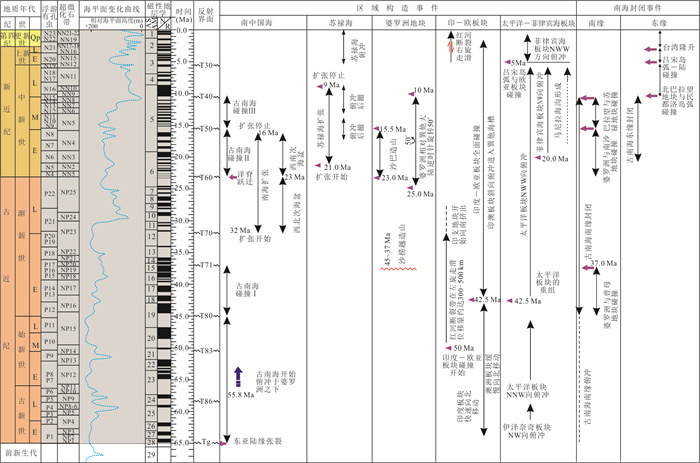
 下载:
下载:
